Our solution for water soluble support material
Our solution for water soluble support material
Hi guys.
To those who are not familiar with it, we stock water soluble PVA plastic. It really expands on the possibilities of what you can do with a dual extrusion machine.
However it is a finicky material as it absorbs ambient moisture pretty quickly and becomes too soft for the pulley to get a grip.
It was then required to come up with a way to keep the plastic dry while printing.
This is what we came up with.
You will need a water tight container (we used a Tupperware) , preferably square shaped that can hold a roll of filament. (21cm diameter by 10cm thickness)
We designed and printed this part where a filament guide tube fits:
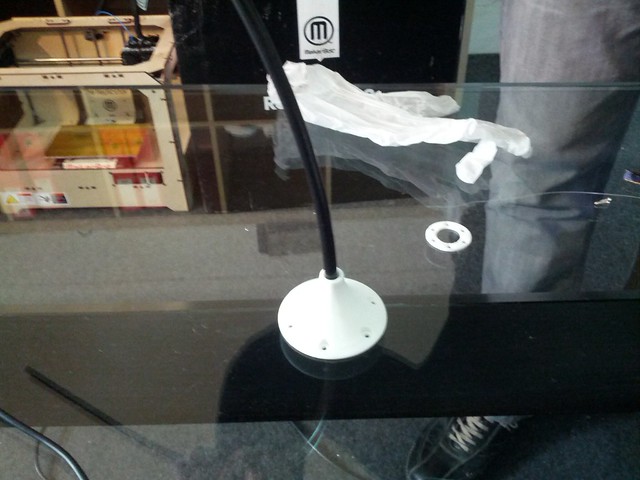
In the bottom it has this ring cut-out. The idea here is to use some flexible material such as latex from a glove, rubber balloon, etc in several layers and use the ring and several screws to secure it over the filament hole.
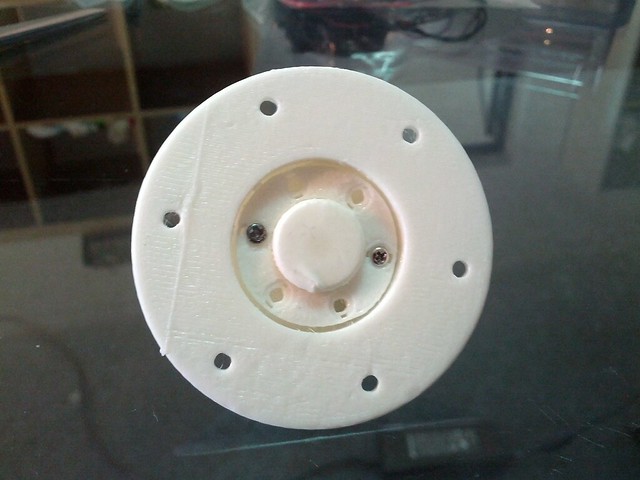
Once that is done puncture the latex with something thin and sharp, like a needle (using stripped copper wire).
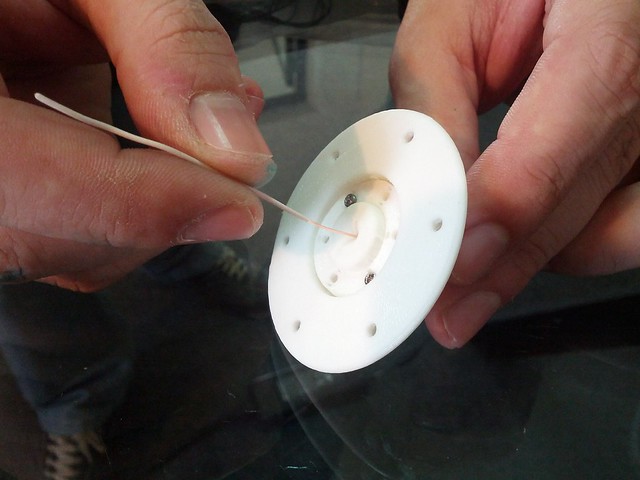
The hole should be much thinner than the filament, meaning it will seal around the filament nicely.
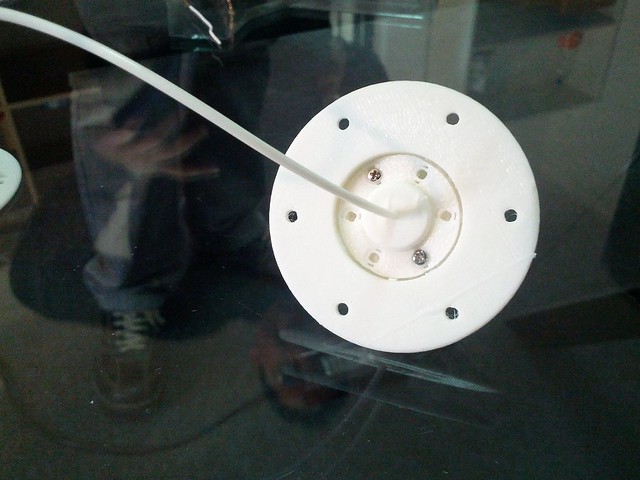
We also designed a support post that is glued in the centre of the Tupperware (also has screw holes in case you want to reinforce it, but hot glue works out fine if you add enough and are quick about it).
The post has a thread on the top to keep the roll in place.
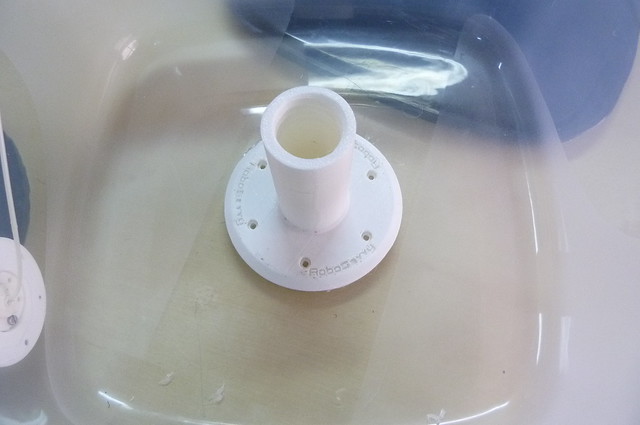
We suggest you use this configuration, so that the roll turns clockwise not to unscrew the cover.
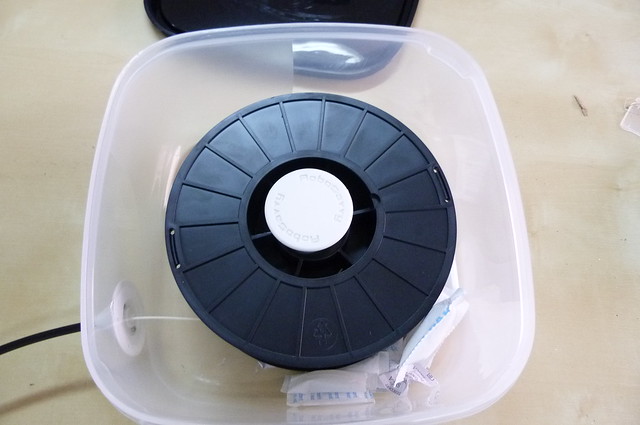
Do a perpendicular to where the filament would come out of the roll if it was half used and drill a hole in the Tupperware up to about 10mm.
If you make it smaller take care to insure the filament exit hole lines up with the hole you made and glue it in place.You can add screws for good measure but it does not seem necessary.
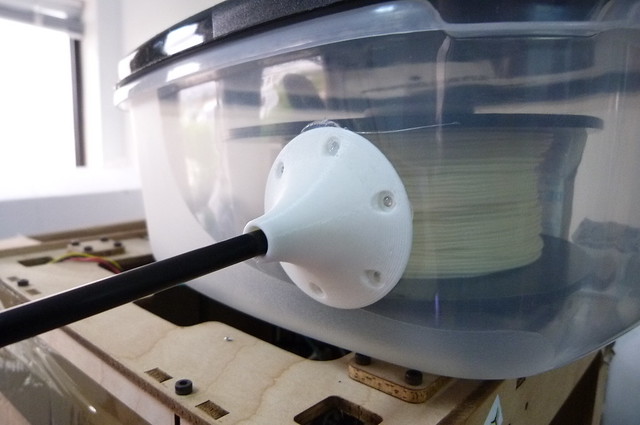
Results so far are very good. After days of sporadic printing the filament inside the box is still dry. The part outside does soften overnight, so at most you have to reject the length that is inside the guide tube a pull out some more until it becomes dry again.
Still it is better to place any extra bags of desiccant you have inside the container to insure everything is nice and dry.
All the files available at: http://www.thingiverse.com/thing:72304
We design most of our parts in CAD software so it is easy to create support material.
However we also get sometimes requests from customer to do custom printing where we just get an STL.
We have been generating the support materials manually, and from the experience gained doing that I hope to be able to create some sort of automatic program to create the support.
Still the results we have been getting printing stuff as complex as DNA molecules are looking very nice:
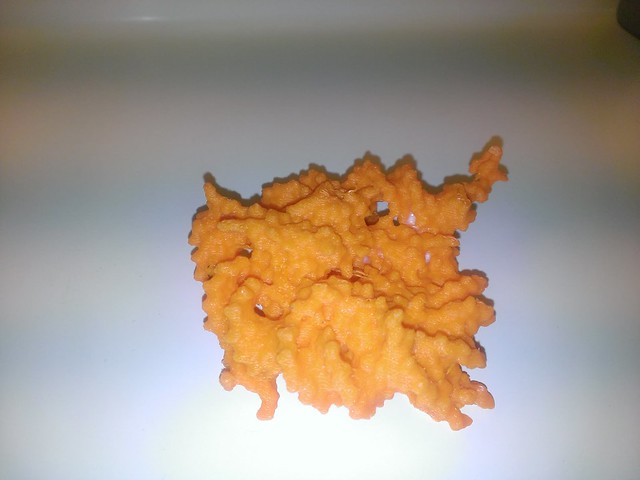
Regards
To those who are not familiar with it, we stock water soluble PVA plastic. It really expands on the possibilities of what you can do with a dual extrusion machine.
However it is a finicky material as it absorbs ambient moisture pretty quickly and becomes too soft for the pulley to get a grip.
It was then required to come up with a way to keep the plastic dry while printing.
This is what we came up with.
You will need a water tight container (we used a Tupperware) , preferably square shaped that can hold a roll of filament. (21cm diameter by 10cm thickness)
We designed and printed this part where a filament guide tube fits:

In the bottom it has this ring cut-out. The idea here is to use some flexible material such as latex from a glove, rubber balloon, etc in several layers and use the ring and several screws to secure it over the filament hole.

Once that is done puncture the latex with something thin and sharp, like a needle (using stripped copper wire).

The hole should be much thinner than the filament, meaning it will seal around the filament nicely.

We also designed a support post that is glued in the centre of the Tupperware (also has screw holes in case you want to reinforce it, but hot glue works out fine if you add enough and are quick about it).
The post has a thread on the top to keep the roll in place.

We suggest you use this configuration, so that the roll turns clockwise not to unscrew the cover.

Do a perpendicular to where the filament would come out of the roll if it was half used and drill a hole in the Tupperware up to about 10mm.
If you make it smaller take care to insure the filament exit hole lines up with the hole you made and glue it in place.You can add screws for good measure but it does not seem necessary.

Results so far are very good. After days of sporadic printing the filament inside the box is still dry. The part outside does soften overnight, so at most you have to reject the length that is inside the guide tube a pull out some more until it becomes dry again.
Still it is better to place any extra bags of desiccant you have inside the container to insure everything is nice and dry.
All the files available at: http://www.thingiverse.com/thing:72304
We design most of our parts in CAD software so it is easy to create support material.
However we also get sometimes requests from customer to do custom printing where we just get an STL.
We have been generating the support materials manually, and from the experience gained doing that I hope to be able to create some sort of automatic program to create the support.
Still the results we have been getting printing stuff as complex as DNA molecules are looking very nice:

Regards
Last edited by MarcoP on Thu Apr 11, 2013 5:13 am, edited 1 time in total.

